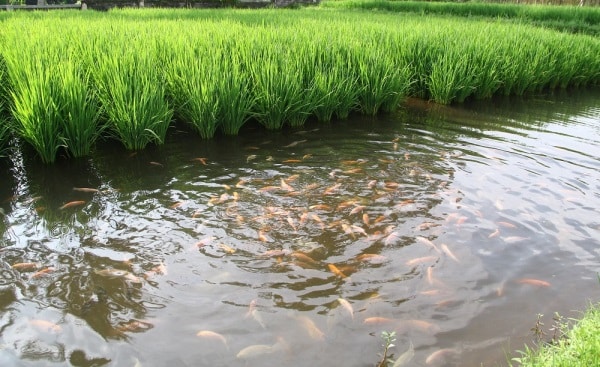Urgent conservation and promotion are vital for India’s rice-fish farming. The co-culture system lowers harmful emissions, increases farm earnings, and backs rural communities and forward-thinking farmers. To solve problems like food security, malnutrition, and environmental concerns, the nation should adopt sustainable farming practices.
Growing rice needs a lot of water and creates a lot of methane, which is a strong greenhouse gas. But in some parts of Asia, they have come up with a clever idea. They grow rice along with fish, crabs, shrimp, and ducks. This helps them use their land and water better and gives them both rice and meat to eat.
The environmental effects of rice farming, includes the release of greenhouse gases like methane and nitrous oxide. Methane, released in waterlogged paddy fields during anaerobic organic matter decomposition, is a potent contributor to global warming, with a Global Warming Potential 25 times higher than carbon dioxide. The farming helps to reduce harmful gases such as methane by adding oxygen and lowering methane release. It’s much better for the environment, about 34.6% better, than just growing rice by itself.
Rice-fish farming not only removes the greenhouse gases, improves soil quality and it also addresses a global issue of soil degradation. Eco-friendly farming approach that requires some chemical inputs such as pesticides and fertilizers ultimately enhance farm productivity. In Bangladesh, rice-fish culture generates over 50 percent higher net income compared to rice monoculture, boasting higher rice yields with reduced labor and material inputs. In Indonesia, it delivers a 27 percent higher net return compared to single-crop rice farming. Co-cultivation promotes strong bonds between agriculture and aquaculture, and it allows sharing knowledge which benefits both industries and farmer’s well being.
In India, where agriculture is the backbone of the economy and supports the majority of the population, embracing the rice-fish co-culture system holds the promise of enhancing agricultural output, curbing environmental degradation, and elevating farmers’ well-being. Although 20 million hectares of land are suitable for rice-fish integration, merely 0.23 million hectares utilize it due to the promotion of high-yield rice varieties reliant on pesticides. The North East region of India, the cradle of rice cultivation, presents significant potential for rice-fish farming. Studies in Assam affirm its eco-friendly, cost-effective, and low-risk nature, delivering multiple benefits to rural communities and aligning with the region’s organic farming focus. This strategy could substantially support fish production.
The rice-fish system in India needs urgent attention and promotion, given its diverse ecological benefits. Policymakers should prioritize research, offer support, and harness its potential for enhanced agriculture and environmental protection.

